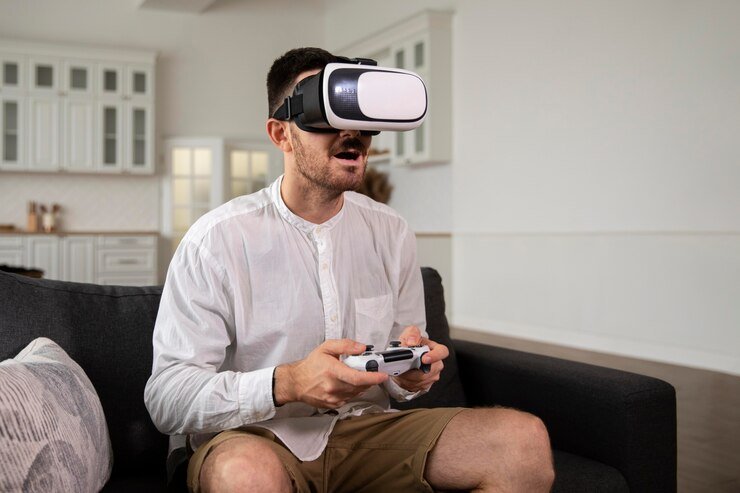Best Virtual Reality (VR) Headsets for Gaming: Top Picks in 2024
Virtual Reality (VR) has rapidly evolved over the past few years, transforming from a niche technology into a mainstream entertainment medium. As VR gaming continues to grow in popularity, the need for high-quality, immersive headsets has never been more important. Whether you’re new to VR or an experienced gamer looking to upgrade, choosing the right headset can make or break your gaming experience. In 2024, several VR headsets stand out due to their superior performance, visual fidelity, comfort, and game selection. Here’s a breakdown of the Best Virtual Reality (VR) Headsets for Gaming this year.
Meta Quest 3: Best for Standalone Gaming
Price: $499 (128GB model)
Pros:
- Standalone device (no PC or console required)
- Excellent performance with a Snapdragon XR2 Gen 2 chip
- 2064 x 2208 pixels per eye
- Comfortable, ergonomic design
- Large library of games and experiences
- Wireless freedom with PC VR support (via Air Link or USB)
Cons:
- Lower fidelity compared to high-end PC VR headsets
- Limited battery life for extended sessions
The Meta Quest 3 is one of the most versatile VR headsets on the market. As a standalone headset, it doesn’t require a PC or console to run, making it perfect for gamers who want a simple, all-in-one solution. Powered by the Snapdragon XR2 Gen 2 processor, it offers a huge performance boost over its predecessor, the Quest 2, and is capable of running high-quality VR experiences with impressive visuals.
The Quest 3’s 2064 x 2208 resolution per eye provides sharp, crisp visuals, and its mixed-reality capabilities let you blend the physical world with digital content in creative ways. Moreover, you can connect it to a PC to unlock even more gaming potential via Meta’s Air Link wireless solution or a USB cable. For users looking for a VR headset that balances ease of use with advanced features, the Quest 3 is an excellent choice.
Valve Index: Best for PC VR Gaming
Price: $999 (full kit, including headset, controllers, and base stations)
Pros:
- Exceptional build quality
- 144Hz refresh rate for ultra-smooth gameplay
- 130° field of view for deep immersion
- Precision tracking with external base stations
- Excellent audio with off-ear speakers
Cons:
- Expensive, especially with the full kit
- Requires a powerful gaming PC
- Setup is more involved compared to standalone devices
The Valve Index is widely regarded as one of the best VR headsets for high-end gaming. For those who already own a capable PC and want the best possible VR experience, the Index delivers outstanding performance. The high refresh rate of up to 144Hz provides smooth, fluid visuals, which is crucial for fast-paced VR gaming. The headset also offers an impressively wide 130° field of view, enhancing the sense of immersion.
The Index uses external base stations for precise tracking, which means it can offer more accurate movement tracking than many other VR systems. Additionally, the headset comes with the “Knuckle” controllers, which allow for more natural hand movements and greater control, especially in games that require detailed interaction.
However, the Valve Index comes at a premium price, and setting up the external base stations can be more involved than with other headsets. But if you’re looking for top-tier PC VR performance, this is the gold standard.
PlayStation VR2: Best for PS5 Owners
Price: $549.99 (headset only)
Pros:
- Stunning OLED display with 4K HDR support
- Advanced haptic feedback and adaptive triggers in controllers
- Wide range of exclusive PlayStation VR titles
- Plug-and-play setup with PlayStation 5
- Enhanced comfort with new design
Cons:
- Only compatible with PlayStation 5
- Limited to Sony’s ecosystem for games and content
For PlayStation 5 owners, the PS VR2 is the obvious choice for VR gaming. With a stunning OLED display offering 4K HDR, a 110° field of view, and 3D audio, it provides a truly immersive experience for gamers. The PlayStation VR2’s Sense controllers integrate adaptive triggers and haptic feedback, which adds an extra layer of immersion, making every interaction in the virtual world feel more tactile and responsive.
In terms of game selection, PS VR2 boasts several exclusive titles like Horizon Call of the Mountain and Gran Turismo 7 in VR, which can’t be found on other platforms. The headset is easy to set up with the PS5, offering plug-and-play convenience, and the overall design has been improved for better comfort during long sessions.
However, the major drawback is that the PS VR2 is only compatible with the PlayStation 5, so if you don’t already own the console, this headset won’t be an option.
HP Reverb G2: Best for Visual Fidelity
Price: $599
Pros:
- Outstanding 2160 x 2160 resolution per eye
- Wide color gamut and excellent contrast
- Comfortable and lightweight design
- Compatible with both SteamVR and Windows Mixed Reality
Cons:
- Tracking isn’t as accurate as other systems (lacks external base stations)
- Requires a powerful PC to run properly
The HP Reverb G2 is a standout for gamers who prioritize visual fidelity. With a resolution of 2160 x 2160 per eye, it offers some of the sharpest images available in VR today. This makes it particularly appealing for simulation games, where detail is crucial. Whether you’re flying a plane in Microsoft Flight Simulator or exploring intricate virtual worlds, the clarity is remarkable.
The G2 also has an impressive color gamut and contrast ratio, providing vibrant, true-to-life visuals. Its lightweight and comfortable design make it ideal for long gaming sessions. The only downside is that the tracking isn’t quite as precise as some other headsets, especially when compared to the Valve Index, but it’s still a solid option for most gamers.
Pimax 12K QLED: Best for Hardcore Enthusiasts
Price: $1,799 (headset only)
Pros:
- Jaw-dropping 12K resolution (7680 x 2160)
- Huge 200° field of view
- Advanced QLED technology for superior color and contrast
- Compatible with both SteamVR and Pimax’s proprietary tracking system
Cons:
- Extremely high price point
- Requires a powerful PC and additional accessories
- Can be overkill for casual users
For VR enthusiasts who want the absolute best, the Pimax 12K QLED represents the pinnacle of VR technology. With a massive 200° field of view and a stunning 12K resolution, it’s an experience like no other. The QLED display enhances color and contrast, creating lifelike visuals that will blow away even the most seasoned VR gamers.
However, this headset is not for everyone. It requires a top-of-the-line PC to function properly, and the price point is prohibitively high for most gamers. But for those who want the ultimate in VR immersion and are willing to invest in the best hardware available, the Pimax 12K QLED is in a league of its own.
The best VR headset for gaming in 2024 depends on your preferences, budget, and platform. The Meta Quest 3 is perfect for those who want a standalone, all-in-one device, while the Valve Index and HP Reverb G2 cater to PC VR enthusiasts who prioritize performance and visual fidelity. PlayStation 5 owners will find the PS VR2 to be an excellent choice, offering seamless integration with their console and access to exclusive games. Lastly, the Pimax 12K QLED is the top pick for hardcore VR enthusiasts who demand the absolute best in terms of resolution and immersion.
No matter your choice, VR gaming in 2024 offers a level of immersion that can’t be matched by traditional gaming setups. The future of virtual reality is here, and these headsets are leading the way.
Frequently Asked Questions (FAQs) About Best Virtual Reality (VR) Headsets for Gaming
1. What do I need to use a VR headset for gaming?
To use a VR headset, you typically need the following:
- A compatible device: Depending on the headset, this could be a PC, a PlayStation 5, or the headset itself (for standalone models like the Meta Quest 3).
- Space for movement: VR gaming often requires room to move around, so make sure you have enough clear space to safely enjoy your games.
- Controllers: Most VR headsets come with their own controllers, but some may require additional accessories (like base stations or motion sensors) for tracking.
- A stable internet connection: For certain games, updates, or multiplayer experiences, a reliable internet connection might be necessary.
2. What’s the difference between standalone and PC VR headsets?
- Standalone VR headsets (e.g., Meta Quest 3) do not require a PC or console to operate. They come with their own built-in processing power and are easy to set up—just put the headset on and play.
- PC VR headsets (e.g., Valve Index, HP Reverb G2) require a powerful gaming PC to run the games. These headsets offer higher fidelity and performance due to the increased processing power of the PC, but they come with more setup and the need for additional peripherals like base stations or external sensors.
3. Do VR headsets work with all games?
No, not all games are compatible with VR headsets. VR gaming requires specific titles that are designed for virtual reality. However, many popular gaming platforms, like Steam and PlayStation, offer a growing library of VR-compatible games. Some non-VR games may also support VR modding, but the experience might not be as polished. Before purchasing a VR headset, it’s a good idea to check the availability of VR titles you want to play.
4. Are VR headsets comfortable to wear for long sessions?
Comfort varies between different VR headsets, but many high-end models like the Meta Quest 3, Valve Index, and PlayStation VR2 are designed with extended play in mind. Features like adjustable head straps, lightweight materials, and padded face cushions can help increase comfort. However, prolonged use may still cause some discomfort, especially if the headset is too tight or doesn’t fit properly. Regular breaks are recommended to avoid discomfort and reduce the risk of VR fatigue.
5. Can I use a VR headset for non-gaming applications?
Yes, VR headsets are not just for gaming—they can also be used for a wide range of applications, including virtual tours, social experiences, productivity tools, and educational content. Many headsets, such as the Meta Quest 3, support social apps (like Meta Horizon Worlds) and productivity software (such as VR versions of Microsoft Office or virtual meetings). For those interested in non-gaming applications, VR offers an exciting and immersive way to experience digital content in various fields.












Post Comment